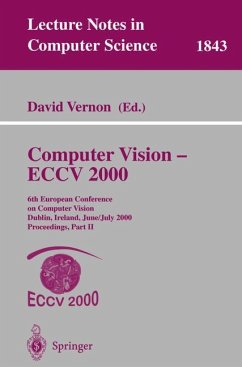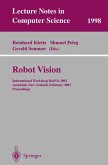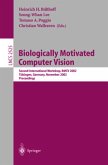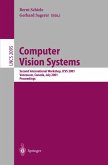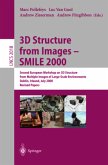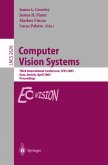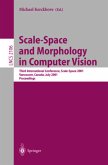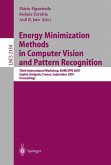David Vernon (ed.)6th European Conference on Computer Vision Dublin, Ireland, June 26 - July 1, 2000, Proceedings, Part II
Computer Vision - ECCV 2000
6th European Conference on Computer Vision Dublin, Ireland, June 26 - July 1, 2000, Proceedings, Part II
Herausgegeben:Vernon, David
David Vernon (ed.)6th European Conference on Computer Vision Dublin, Ireland, June 26 - July 1, 2000, Proceedings, Part II
Computer Vision - ECCV 2000
6th European Conference on Computer Vision Dublin, Ireland, June 26 - July 1, 2000, Proceedings, Part II
Herausgegeben:Vernon, David
- Broschiertes Buch
- Merkliste
- Auf die Merkliste
- Bewerten Bewerten
- Teilen
- Produkt teilen
- Produkterinnerung
- Produkterinnerung
The two-volume set LNCS 1842/1843 constitutes the refereed proceedings of the 6th European Conference on Computer Vision, ECCV 2000, held in Dublin, Ireland in June/July 2000. The 116 revised full papers presented were carefully selected from a total of 266 submissions. The two volumes offer topical sections on recognitions and modelling; stereoscopic vision; texture and shading; shape; structure from motion; image features; active, real-time, and robot vision; segmentation and grouping; vision systems engineering and evaluation; calibration; medical image understanding; and visual motion.
Andere Kunden interessierten sich auch für
![Robot Vision Robot Vision]() Reinhard Klette / Shmuel Peleg / Gerald Sommer (eds.)Robot Vision41,99 €
Reinhard Klette / Shmuel Peleg / Gerald Sommer (eds.)Robot Vision41,99 €![Biologically Motivated Computer Vision Biologically Motivated Computer Vision]() Heinrich H. Bülthoff / Seong-Whan Lee / Tomaso Poggio / Christian Wallraven (eds.)Biologically Motivated Computer Vision82,99 €
Heinrich H. Bülthoff / Seong-Whan Lee / Tomaso Poggio / Christian Wallraven (eds.)Biologically Motivated Computer Vision82,99 €![Computer Vision Systems Computer Vision Systems]() Bernt Schiele / Gerhard Sagerer (eds.)Computer Vision Systems41,99 €
Bernt Schiele / Gerhard Sagerer (eds.)Computer Vision Systems41,99 €![3D Structure from Images - SMILE 2000 3D Structure from Images - SMILE 2000]() Marc Pollefeys / Luc van Gool / Andrew Zisserman / Andrew Fitzgibbon (eds.)3D Structure from Images - SMILE 200041,99 €
Marc Pollefeys / Luc van Gool / Andrew Zisserman / Andrew Fitzgibbon (eds.)3D Structure from Images - SMILE 200041,99 €![Computer Vision Systems Computer Vision Systems]() James Crowley / Justus Piater / Markus Vincze / Lucas Paletta (eds.)Computer Vision Systems81,99 €
James Crowley / Justus Piater / Markus Vincze / Lucas Paletta (eds.)Computer Vision Systems81,99 €![Scale-Space and Morphology in Computer Vision Scale-Space and Morphology in Computer Vision]() Michael Kerckhove (ed.)Scale-Space and Morphology in Computer Vision41,99 €
Michael Kerckhove (ed.)Scale-Space and Morphology in Computer Vision41,99 €![Energy Minimization Methods in Computer Vision and Pattern Recognition Energy Minimization Methods in Computer Vision and Pattern Recognition]() Mario A.T. Figueiredo / Josiane Zerubia / Anil K. Jain (eds.)Energy Minimization Methods in Computer Vision and Pattern Recognition82,99 €
Mario A.T. Figueiredo / Josiane Zerubia / Anil K. Jain (eds.)Energy Minimization Methods in Computer Vision and Pattern Recognition82,99 €-
-
-
The two-volume set LNCS 1842/1843 constitutes the refereed proceedings of the 6th European Conference on Computer Vision, ECCV 2000, held in Dublin, Ireland in June/July 2000. The 116 revised full papers presented were carefully selected from a total of 266 submissions. The two volumes offer topical sections on recognitions and modelling; stereoscopic vision; texture and shading; shape; structure from motion; image features; active, real-time, and robot vision; segmentation and grouping; vision systems engineering and evaluation; calibration; medical image understanding; and visual motion.
Hinweis: Dieser Artikel kann nur an eine deutsche Lieferadresse ausgeliefert werden.
Hinweis: Dieser Artikel kann nur an eine deutsche Lieferadresse ausgeliefert werden.
Produktdetails
- Produktdetails
- Lecture Notes in Computer Science 1843
- Verlag: Springer / Springer Berlin Heidelberg / Springer, Berlin
- Artikelnr. des Verlages: 978-3-540-67686-7
- 2000.
- Seitenzahl: 904
- Erscheinungstermin: 19. Juni 2000
- Englisch
- Abmessung: 235mm x 155mm x 55mm
- Gewicht: 1503g
- ISBN-13: 9783540676867
- ISBN-10: 3540676864
- Artikelnr.: 27519356
- Herstellerkennzeichnung Die Herstellerinformationen sind derzeit nicht verfügbar.
- Lecture Notes in Computer Science 1843
- Verlag: Springer / Springer Berlin Heidelberg / Springer, Berlin
- Artikelnr. des Verlages: 978-3-540-67686-7
- 2000.
- Seitenzahl: 904
- Erscheinungstermin: 19. Juni 2000
- Englisch
- Abmessung: 235mm x 155mm x 55mm
- Gewicht: 1503g
- ISBN-13: 9783540676867
- ISBN-10: 3540676864
- Artikelnr.: 27519356
- Herstellerkennzeichnung Die Herstellerinformationen sind derzeit nicht verfügbar.
Recognition & Modelling I.- Partitioned Sampling, Articulated Objects, and Interface-Quality Hand Tracking.- Real-Time Tracking of Multiple Articulated Structures in Multiple Views.- Pedestrian Detection from a Moving Vehicle.- Vision-Based Guidance and Control of Robots in Projective Space.- Stereoscopic Vision.- A General Method for Unsupervised Segmentation of Images Using a Multiscale Approach.- Image Segmentation by Nonparametric Clustering Based on the Kolmogorov-Smirnov Distance.- Euclidean Group Invariant Computation of Stochastic Completion Fields Using Shiftable-Twistable Functions.- Recognition & Modelling / Stereoscopic Vision / Texture, Shading, & Colour.- Bootstrap Initialization of Nonparametric Texture Models for Tracking.- Quasi-Random Sampling for Condensation.- Tracking Discontinuous Motion Using Bayesian Inference.- Direction Control for an Active Docking Behaviour Based on the Rotational Component of Log-Polar Optic Flow.- The Construction of 3 Dimensional Models Using an Active Computer Vision System.- Significantly Different Textures: A Computational Model of Pre-attentive Texture Segmentation.- Calibrating Parameters of Cost Functionals.- Coupled Geodesic Active Regions for Image Segmentation: A Level Set Approach.- Level Lines as Global Minimizers of Energy Functionals in Image Segmentation.- A Probabilistic Interpretation of the Saliency Network.- Layer Extraction with a Bayesian Model of Shapes.- Model-Based Initialisation for Segmentation.- Statistical Foreground Modelling for Object Localisation.- Nautical Scene Segmentation Using Variable Size Image Windows and Feature Space Reclustering.- A Probabilistic Background Model for Tracking.- On the Performance Characterisation of Image Segmentation Algorithms: A Case Study.- Statistical Significance as an Aid to System Performance Evaluation.- New Algorithms for Controlling Active Contours Shape and Topology.- Motion Segmentation by Tracking Edge Information over Multiple Frames.- Data-Driven Extraction of Curved Intersection Lanemarks from Road Traffic Image Sequences.- Tracking and Characterization of Highly Deformable Cloud Structures.- Calibration.- A Unifying Theory for Central Panoramic Systems and Practical Implications.- Binocular Self-Alignment and Calibration from Planar Scenes.- The Rôle of Self-Calibration in Euclidean Reconstruction from Two Rotating and Zooming Cameras.- Hand-Eye Calibration from Image Derivatives.- Medical Image Understanding.- Multimodal Elastic Matching of Brain Images.- A Physically-Based Statistical Deformable Model for Brain Image Analysis.- Minimal Paths in 3D Images and Application to Virtual Endoscopy.- Calibration / Medical Image Understanding / Visual Motion.- Kruppa Equation Revisited: Its Renormalization and Degeneracy.- Registration with a Moving Zoom Lens Camera for Augmented Reality Applications.- Calibration of a Moving Camera Using a Planar Pattern: Optimal Computation, Reliability Evaluation, and Stabilization by Model Selection.- Multi-view Constraints between Collineations: Application to Self-Calibration from Unknown Planar Structures.- Stereo Autocalibration from One Plane.- Can We Calibrate a Camera Using an Image of a Flat,Textureless Lambertian Surface?.- Underwater Camera Calibration.- On Weighting and Choosing Constraints for Optimally Reconstructing the Geometry of Image Triplets.- Computation of the Mid-Sagittal Plane in 3D Images of the Brain.- Stochastic Tracking of 3D Human Figures Using 2D Image Motion.- Monocular Perception of Biological Motion - Clutter and Partial Occlusion.- 3-D Motion and Structure from 2-D Motion Causally Integrated over Time: Implementation.- Non-parametric Model for Background Subtraction.- Qualitative Spatiotemporal Analysis Using an Oriented Energy Representation.- Regularised Range Flow.- Visual Encoding of Tilt from Optic Flow: Psychophysics and Computational Modelling.- Visual Motion.- IMPSAC: Synthesis of Importance Sampling and Random Sample Consensus.- Egomotion Estimation Using Quadruples of Collinear Image Points.- Geometric Driven Optical Flow Estimation and Segmentation for 3D Reconstruction.- Camera Pose Estimation and Reconstruction from Image Profiles under Circular Motion.
Recognition & Modelling I.- Partitioned Sampling, Articulated Objects, and Interface-Quality Hand Tracking.- Real-Time Tracking of Multiple Articulated Structures in Multiple Views.- Pedestrian Detection from a Moving Vehicle.- Vision-Based Guidance and Control of Robots in Projective Space.- Stereoscopic Vision.- A General Method for Unsupervised Segmentation of Images Using a Multiscale Approach.- Image Segmentation by Nonparametric Clustering Based on the Kolmogorov-Smirnov Distance.- Euclidean Group Invariant Computation of Stochastic Completion Fields Using Shiftable-Twistable Functions.- Recognition & Modelling / Stereoscopic Vision / Texture, Shading, & Colour.- Bootstrap Initialization of Nonparametric Texture Models for Tracking.- Quasi-Random Sampling for Condensation.- Tracking Discontinuous Motion Using Bayesian Inference.- Direction Control for an Active Docking Behaviour Based on the Rotational Component of Log-Polar Optic Flow.- The Construction of 3 Dimensional Models Using an Active Computer Vision System.- Significantly Different Textures: A Computational Model of Pre-attentive Texture Segmentation.- Calibrating Parameters of Cost Functionals.- Coupled Geodesic Active Regions for Image Segmentation: A Level Set Approach.- Level Lines as Global Minimizers of Energy Functionals in Image Segmentation.- A Probabilistic Interpretation of the Saliency Network.- Layer Extraction with a Bayesian Model of Shapes.- Model-Based Initialisation for Segmentation.- Statistical Foreground Modelling for Object Localisation.- Nautical Scene Segmentation Using Variable Size Image Windows and Feature Space Reclustering.- A Probabilistic Background Model for Tracking.- On the Performance Characterisation of Image Segmentation Algorithms: A Case Study.- Statistical Significance as an Aid to System Performance Evaluation.- New Algorithms for Controlling Active Contours Shape and Topology.- Motion Segmentation by Tracking Edge Information over Multiple Frames.- Data-Driven Extraction of Curved Intersection Lanemarks from Road Traffic Image Sequences.- Tracking and Characterization of Highly Deformable Cloud Structures.- Calibration.- A Unifying Theory for Central Panoramic Systems and Practical Implications.- Binocular Self-Alignment and Calibration from Planar Scenes.- The Rôle of Self-Calibration in Euclidean Reconstruction from Two Rotating and Zooming Cameras.- Hand-Eye Calibration from Image Derivatives.- Medical Image Understanding.- Multimodal Elastic Matching of Brain Images.- A Physically-Based Statistical Deformable Model for Brain Image Analysis.- Minimal Paths in 3D Images and Application to Virtual Endoscopy.- Calibration / Medical Image Understanding / Visual Motion.- Kruppa Equation Revisited: Its Renormalization and Degeneracy.- Registration with a Moving Zoom Lens Camera for Augmented Reality Applications.- Calibration of a Moving Camera Using a Planar Pattern: Optimal Computation, Reliability Evaluation, and Stabilization by Model Selection.- Multi-view Constraints between Collineations: Application to Self-Calibration from Unknown Planar Structures.- Stereo Autocalibration from One Plane.- Can We Calibrate a Camera Using an Image of a Flat,Textureless Lambertian Surface?.- Underwater Camera Calibration.- On Weighting and Choosing Constraints for Optimally Reconstructing the Geometry of Image Triplets.- Computation of the Mid-Sagittal Plane in 3D Images of the Brain.- Stochastic Tracking of 3D Human Figures Using 2D Image Motion.- Monocular Perception of Biological Motion - Clutter and Partial Occlusion.- 3-D Motion and Structure from 2-D Motion Causally Integrated over Time: Implementation.- Non-parametric Model for Background Subtraction.- Qualitative Spatiotemporal Analysis Using an Oriented Energy Representation.- Regularised Range Flow.- Visual Encoding of Tilt from Optic Flow: Psychophysics and Computational Modelling.- Visual Motion.- IMPSAC: Synthesis of Importance Sampling and Random Sample Consensus.- Egomotion Estimation Using Quadruples of Collinear Image Points.- Geometric Driven Optical Flow Estimation and Segmentation for 3D Reconstruction.- Camera Pose Estimation and Reconstruction from Image Profiles under Circular Motion.

